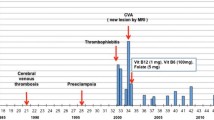Abstract
Venous and arterial thromboembolism can occur in patients with homocystinuria. Resistance to activated protein C, which is caused by a single point mutation in the gene for factor V, renders an individual at risk for thrombosis. It has been suggested that coexistence of hereditary homocystinuria and factor V Leiden mutation might jointly play a role in the development of thrombosis. We analysed six patients with homocystinuria due to cystathionine β-synthase deficiency for factor V Leiden and prothrombin G20210A mutations. Only one patient was found to have the factor V Leiden mutation in homozygous form and this patient had suffered from severe thrombosis. One patient was found to be heterozygous with no documented thrombosis. None of the patients had prothrombin G20210A mutation. We stress the necessity for screening for known thrombophilic risk factors in patients with cystathonine β-synthase deficiency. The coexistence of the factor V Leiden mutation can cause severe thrombotic events in patients with homocystinuria.
Similar content being viewed by others
REFERENCES
Andria G, Sebastio G (1996) Homocystinuria due to cystathionine β-synthase deficiency and related disorders. In: Fernandes J, Saudubray JM, van den Berghe G, eds. Inborn Metabolic Diseases: Diagnosis and Treatment, 2nd edn. Berlin: Springer-Verlag, 177-183.
Bertina RM, Koeleman BPC, Koster T, et al (1994) Mutation in blood coagulation factor V associated with resistance to activated protein C. Nature 369: 64-67.
Dahlback B, Carlsson M, Svensson PJ (1993) Familial thrombophilia due to a previously unrecognized mechanism characterized by poor anticoagulant response to activated protein C: prediction of a cofactor to activated protein C. Proc Natl Acad Sci USA 90: 1004-1008.
Gürgey A, Mesci L (1997) The prevalence of factor V Leiden mutation in Turkish population. Turk J Pediatr 39: 310-315.
Gürgey A, Mesci L, Renda Y, Olcay L, Kocak N, Erdem G (1996) Factor V Leiden mutation in children with thrombosis. Am J Hematol 53: 37-39.
Mandel H, Brenner B, Berant M, et al (1996) Coexistence of hereditary homocystinuria and factor V Leiden-effect on thrombosis. N Engl J Med 334: 763-768.
Poort SR, Rosendaal FP, Reitsma PH, Bertina RM (1996) A common genetic variation in the 3'-untranslated region of the prothrombin gene is associated with elevated plasma prothrombin levels and an increase in venous thrombosis. Blood 88: 3698-3703.
Rosen SB, Sturk A (1997) Activated protein C resistance—a major risk factor for thrombosis. Eur J Clin Chem Clin Biochem 35(7): 501-516.
Welch GN, Loscalzo J (1998) Homocysteine and atherothrombosis. N Engl J Med 338: 1042-1049.
Yap S, O'Donnell KA, O'Neill C, Mayne PD, Thornton P, Naughten E (1999) Factor V Leiden (Arg506Gln), a confounding genetic risk factor but not mandatory for the occurrence of venous thromboembolism in homozygotes and obligate heterozygotes for cystathionine β-synthase deficiency. Thromb Haemost 81: 502-505.
Author information
Authors and Affiliations
Rights and permissions
About this article
Cite this article
Kalkanoğlu, H.S., Coşkun, T., Aydoğdu, S.D. et al. Factor V Leiden mutation in Turkish patients with homozygous cystathionine β-synthase deficiency. J Inherit Metab Dis 24, 367–369 (2001). https://doi.org/10.1023/A:1010556603183
Issue Date:
DOI: https://doi.org/10.1023/A:1010556603183




